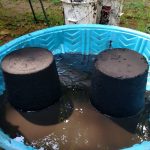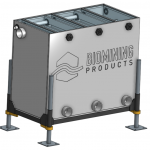#17: PermaCycler: The Next Agricultural Revolution
A bold statement. One we, the US Patent Office, and more and more researchers are willing to commit to.
The PermaCycler (Mk401 pictured above) is a wetland in a box whose atmosphere and water lines are connected to a green house or indoor grow room. The plants inside the grow room produce oxygen through photosynthesis which the wetland “breathes in”. It exhales carbon dioxide (just like you and me) which the plants “inhale” and need to grow fast and big.
When the plant and wetland biomass are in balance, the plants provide enough oxygen to break down all of the waste plant mass feeding the PermaCycler’s microbial biomass. These microbes break down the plant mass into water, carbon dioxide, heat, and more microbes. These oxygen breathing microbes exhale carbon dioxide back to the grow room.
1.5% CO2 is considered optimum for a grow room, and a little extra doesn’t hurt when its free.
This carbon neutral ecosystem mimics the larger planetary carbon/oxygen/photosynthesis cycles. The difference is we use biology to directly cycle carbon dioxide/oxygen at room temperature using electricity to run the pump and aerobic microbes to catalyze the process at very high rates.
Lesser alternatives to providing CO2 are burning natural gas (fossil fuel) and dealing with the extra heat and humidity (more energy), installing a CO2 bottle system with high pressure and a required outside supplier, or a slow exhaling and bulky fungi bag which can’t be easily controlled.
The PermaCyler stands as a superior and novel alternative to all of the above.
Q? Whats the best fertilizer for a plant?
A. That same plant broken down into its water soluble constituents by microbes.
I went into this in excruciating detail in “#5: What is a PermaCycler and how can it increase my grow’s output?“.
So can we really claim that the PermaCycler is the Next Agricultural Revolution?
Never in history has a grow room and wetland bioreactor been directly connected to provide for one another’s immediate atmospheric needs. One “breathes” for the other. The cycle continues endlessly as long as the sun is shining or the lights are on.
By recycling not only the water and nutrients, but the waste plant mass from previous growth cycles, the PermaCycler eliminates many or all externalities associated with plant mass waste, pest control, nutrient pollution, and nutrient and carbon amendments costs.
I’ll go into more points later, but I’d like to leave you with a final piece of evidence (PermaCyclers in Space!)
Cheers!
Colin





